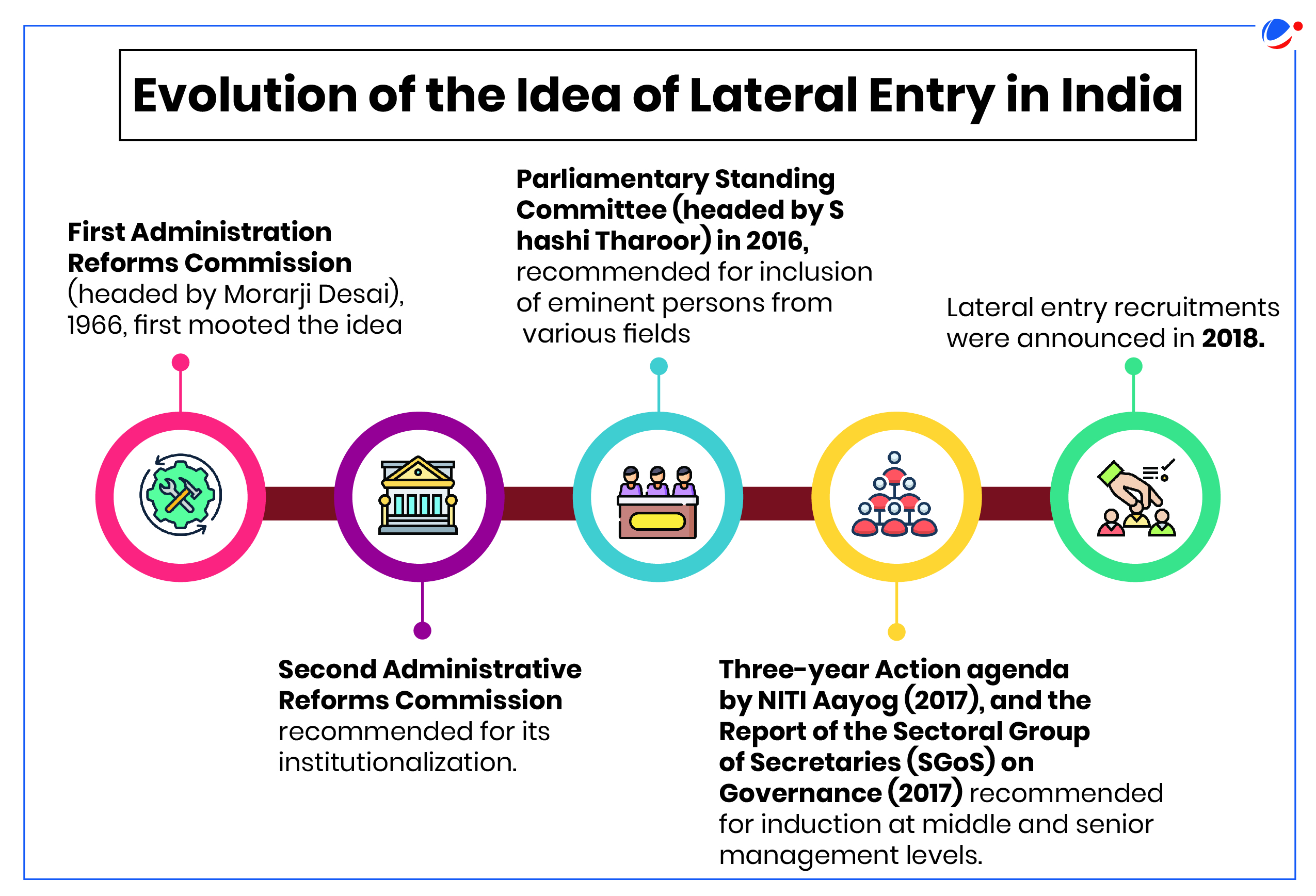Why in the News?
A recent UPSC advertisement for recruitment to 45 lateral entry posts of Secretary and Joint Secretary at the Centre was withdrawn.
More on the News
- The advertisement for lateral entries was withdrawn due to criticism as there are no quotas for SC, ST and OBC candidates in such recruitment.
- According to a letter by DoPT to the UPSC (in November 2018)
- The present arrangement of filling up these posts may be deemed as a close approximation of deputation, where mandatory reservation for SC/ST/OBC is not necessary.
- However, if duly eligible SC/ST/OBC candidates are eligible, they should be considered and priority may be given to such candidates in similarly situated cases for ensuring holistic representation.
How have lateral entries been kept out of the ambit of reservation?
|
About Lateral Entry
- Lateral Entry offers recruitment to persons from outside the usual bureaucratic setup for certain posts in government departments at mid or senior-level positions.
- It is unlike the traditional hiring system where posts are filed based on merit through an exam conducted by the Union Public Service Commission (UPSC).
- It is different from the appointment of private sector employees for advisory roles.
- Example: Appointment of Chief Economic Advisor of India, usually a prominent economist.
- It is contractual employment for 3 to 5 years (extension of tenure based on performance).
- Countries like Australia, USA, and the UK follow both the direct entry (via exam) and lateral entry.

Advantages of lateral entry system
- Addressing Shortfall of Officers: Only 442 IAS officers are working with the Centre, against the required strength of 1,469 officers (2023-24 Demands for Grants report of DOPT).
- Baswan Committee (2016) had also supported lateral entry considering the shortage of officers.
- Increase in efficiency and governance: Lateral entry "brings competition to the established career bureaucracy" (NITI Aayog).
- Inclusion of Domain Experts: Hiring individuals with experience in economics, finance, and technology like robotics, Artificial Intelligence, Cryptocurrency, etc. could bring a fresh perspective to public policy.
- Dealing with Departmental Necessities: Certain ministries/departments are required to work in tandem with the private sector like civil aviation, environment, climate change, etc.
Issues associated with Lateral Entry
- Short-Term Focus: Appointments for 3 to 5 years may lead to short-term policy goals, lacking long-term vision and impact.
- Conflict with Constitutional mandate: Recruitment being outside the purview of India's reservation policy affects the larger goal of social justice and equity.
- Conflict of Interest: Private sector individuals may influence government decisions for profit, risking "revolving door" governance.
- Revolving door governance refers to public officers switching between public service and lobbying roles witnessed in USA.
- Accountability issues: Holding private sector appointees accountable is difficult due to their short tenure.
- Lack of grassroots-level experience: Administrative rules require diverse experiences, not just specialized skills, and understanding local dynamics is crucial.
- Political interference: Political interference in the Selection process may promote nepotism and favouritism.
Way forward
Reforms in the process of lateral entry complemented by the following steps would facilitate resolving the issues of vacancies and ensuring competency and merit in the system.
- Establishing Public Administration University: It can create a large pool of aspiring civil servants and enable serving bureaucrats to attain deep knowledge of the country's economy, increased domain expertise and improved managerial skills.
- Deputation to Private Sector: Deputation of IAS and IPS officers in private sector will bring in domain expertise and competition.
- Institutionalize goal setting and tracking for each department: Each Ministry and government agency should set outcome-based goals with a clear timeline.
- Utilization of Capacity Building Commission and Mission Karmayogi to impart mid-career training aligning with the role of officers.
- Fostering Career Management in Civil Services: Civil Servants should be allowed for acquiring knowledge across sectors in initial years followed by specialised knowledge in specific domains matching their interests.
- Offering study breaks to acquire greater specialisation in the field of interest.
- Two-Tier entry system: D. Subbarao (former RBI Governor) recommended a two-tier entry into IAS, first usual at 25-30 years followed by 37-42 years via lateral entry.
- Such mid-level hiring can bring in expertise from diverse fields into civil services.



